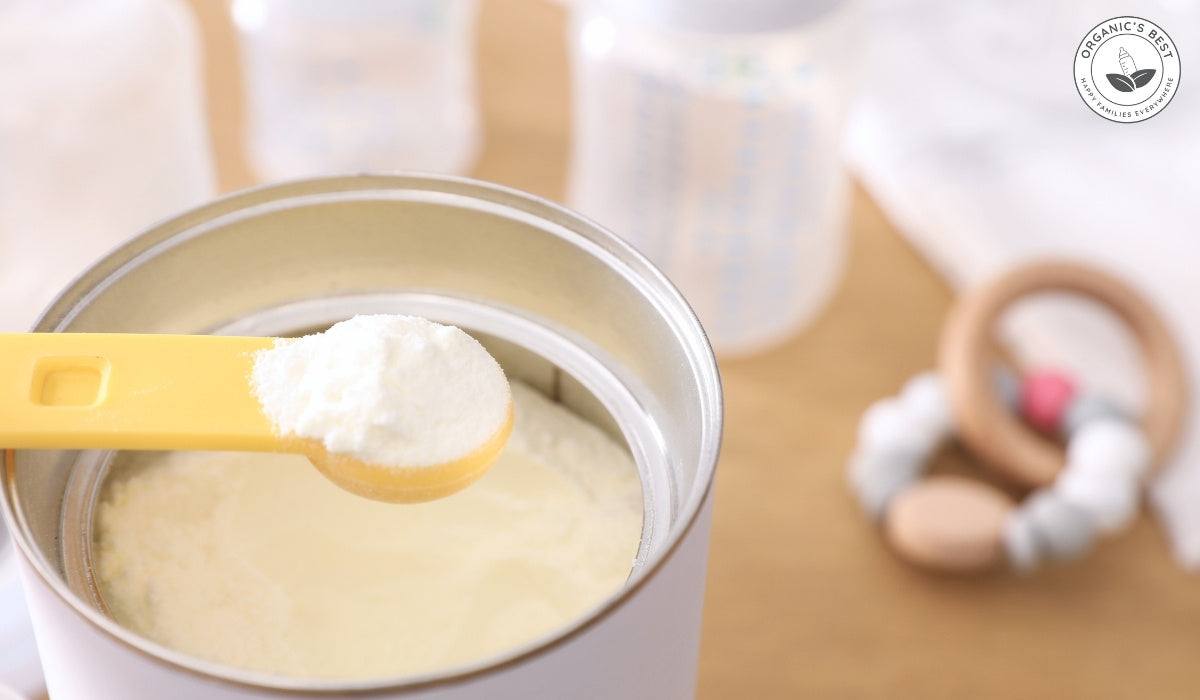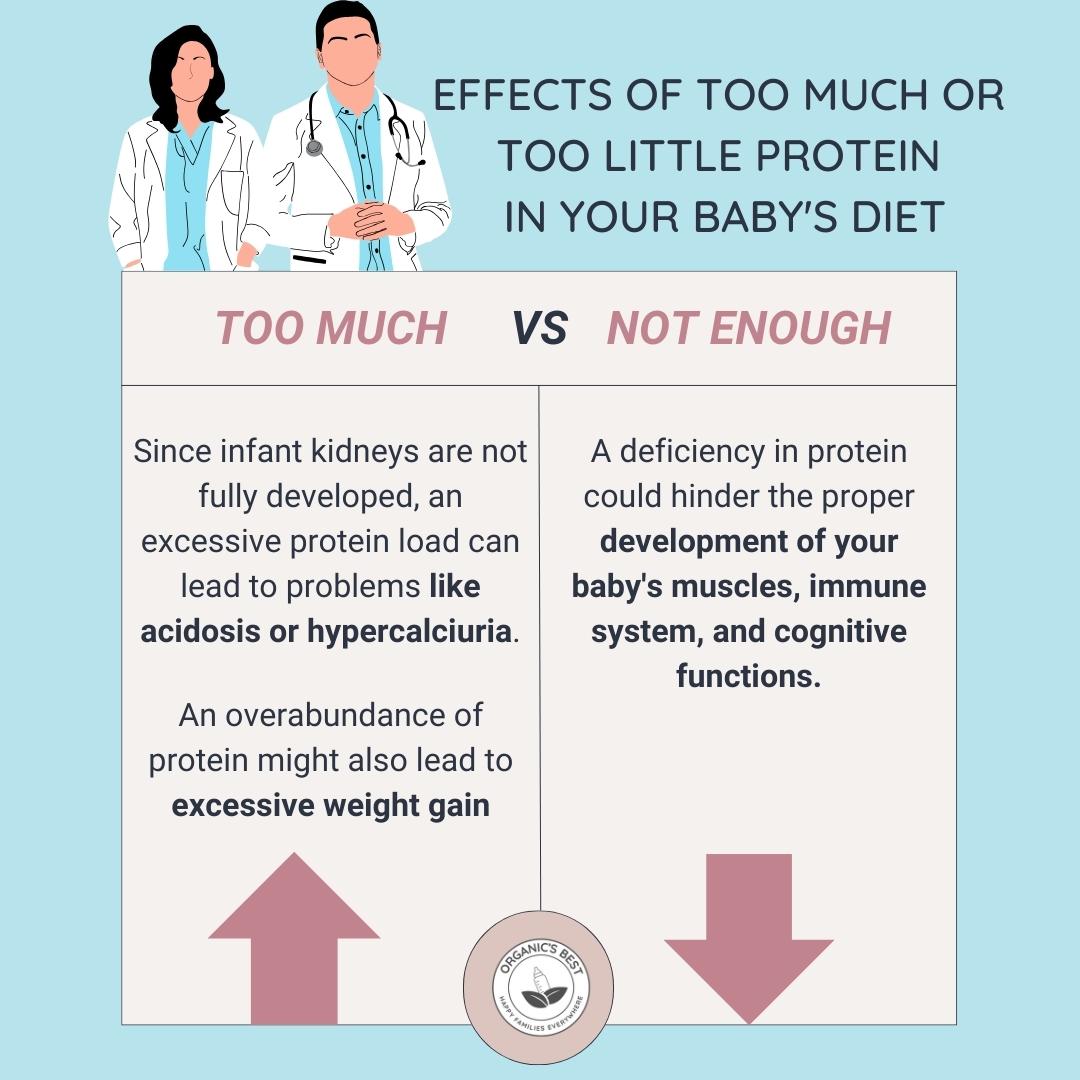Click to Get 2 FREE Boxes/Cans
Only New Customers! Click HERE to Get 2 Extra Boxes/Cans for Free With Your First Order.
BABY FORMULA
Offering new parents top-quality European infant formula from renowned brands like HiPP, Holle, Kendamil, and more. If you’re uncertain about which product to choose, our Formula Finder can help you make the best decision for your baby.
Baby Food
Offering new parents a premium selection of European baby foods, including jars, pouches, cereals, and snacks from esteemed brands like HiPP and Holle.
Understanding Protein in Formula
by Agustina Fernandez October 10, 2023 11 min read

Parenthood is a remarkable adventure filled with moments of joy and discovery, yet it also comes with its fair share of uncertainties, particularly when it comes to choosing the right nourishment for your precious little one. In a landscape brimming with scientific terminology and a myriad of options, it's natural to seek clarity and guidance.
This is where our comprehensive guide steps in – to shed light on the intricacies of baby formula components, helping you make informed decisions that align with your child's well-being. Our goal with this guide is to uncover the diverse proteins found within baby formulas, as well as discuss their significance and benefits to enlighten you about the nourishing elixir that is infant formula!
Table of contents
-
The Role of Protein in Infant Formula
- The Big Players: Common Types of Protein in Infant Formulas
- The Perfect Balance: Whey-to-Casein Ratio
- Other Proteins Found in Infant Formulas
- The Protein Content: How Much is Enough?
- Special Considerations: Allergies and Sensitivities to Formula Proteins
- A Deep Dive: Frequently Asked Questions About Formula Proteins
The Role of Protein in Infant Formula
So, let's start at the beginning: Why is it so important for protein to be included in infant formula?

1) Growth and Development 🌱: Proteins act as architects, building your baby's body, including organs, muscles, and bones. They create new cells and repair existing ones, forming the foundation for growth.
2) Brain Development 🧠: Proteins are crucial for brain growth. They help create chemicals that send messages between brain cells, supporting cognitive and neurological development.
3) Immune System Function 🦠: Proteins play a role in the immune system by producing antibodies, which defend against illnesses. They help strengthen your baby's defences and reduce vulnerability to diseases.
4) Sustained Energy and Appetite Management ⚡: Eating protein helps your baby feel full after meals. This controls overeating, promotes balanced eating habits, and helps manage appetite.
5) Strength 💪: Proteins are essential for muscle growth. They create muscle proteins, contributing to physical strength, mobility, and overall development.
6) Nutrient Absorption and Utilization 🍽️: Proteins contribute to the formation of enzymes that facilitate the absorption and utilization of vitamins and minerals, helping to ensure that the body's processes work together smoothly for optimal health.
Types of Formula
Ensuring an ample supply of protein in your baby's diet is essential for their holistic growth, well-being, and development. Both breast milk and infant formula strive to provide a perfect balance of proteins, along with other vital nutrients.
There are many different types of baby formulas to choose from, all of which are made to be nutritionally complete.
Some of the most common are:
-
Cow milk-based formulas, fortified to resemble the nutrient content of breast milk, are commonly chosen due to their balanced composition.
-
Goat milk-based formulas can be as an alternative for some infants with sensitivities to cow's milk, but it's important to note that many babies who are sensitive to cow's milk protein may also react to goat's milk protein. Therefore, it is not generally recommended as a suitable alternative for infants with cow's milk protein allergies. Additionally, goat milk formula is not suitable for babies with lactose intolerance, as it contains lactose.
-
Specialized formulas intended for infants with specific health concerns or allergies provide tailored nutrition.
-
Soy-based formulas and rice-based formulas, both plant-based proteins, serve as an alternative for families seeking a milk-free baby formula option or for infants with certain unique dietary needs, such as lactose intolerance. However, soy-based formulas are not recommended for premature infants or those with a congenital condition known as galactosemia.
The Big Players: Common Types of Protein in Infant Formulas
Whey and casein are two distinct types of proteins used in infant formulas, each offering unique benefits and characteristics. Did you know that they're found in breast milk, cow's milk, and even milk from other mammals?

Casein: What is it, and Why is it Used in Baby Formula?
In cow's milk, the main protein is casein, making up around 80% of the protein, with whey accounting for about 20%. This vital protein plays a significant role in supporting a baby's growth and development. Casein is a great source of essential amino acids crucial for tissue building and repair.
An interesting distinction arises within cow milk's casein profile, with the presence of A1 and A2 beta-casein variants. A1 beta-casein has been linked to digestive discomfort in some individuals, whereas A2 beta-casein is believed to be more easily tolerated. A few studies suggest that A1 beta-casein may be linked to diabetes, heart disease, and SIDS. Still, results are mixed and more research is needed.
For parents seeking a gentler cow's milk-based formula option, our Holle A2 milk baby formula presents an appealing choice. Harnessing the benefits of A2 beta-casein, Holle A2 milk formula aims to provide a smoother digestion experience for infants!
Learn More: Best Formula for Sensitive Stomachs
Whey: Understanding this Other Common Protein in Infant Formula
Whey proteins are renowned for their ease of digestibility. Whey protein is quickly absorbed by the body, providing rapid nourishment and energy. The protein composition in breast milk varies by stage, with whey accounting for 50% to 80% of the content.
It forms a more delicate curd in the stomach compared to casein, resulting in quicker and smoother digestion. Given that infants possess immature digestive systems, formulas with a higher whey-to-casein protein ratio tend to be gentler on their delicate stomachs.
Soy Protein: An Alternative to Dairy-Based Proteins
For infants with cow milk allergies, lactose intolerance, or families adhering to a plant-based lifestyle, soy-based baby formulas offer a viable alternative. Soy protein isolate, derived from soybeans, serves as the foundation of these formulas.
Additionally, soy-based infant formulas contain phytochemicals known as phytoestrogens, which have similarities to the hormone estrogen. While concerns have been raised about the potential effects of phytoestrogens on infant development, research indicates that soy formulas are likely safe for consumption and do not adversely affect growth, development, or reproductive health when used as directed by your pediatrician.
However, it's worth noting that the long-term effects of phytoestrogens on infant development have not been conclusively established, and caution may be warranted in certain cases.
It's essential to note that while soy formula is a valuable option for certain infants, it may not be suitable for all cases. For instance, soy, for some babies with cow's milk protein allergy, may also trigger allergic responses.
Thus, consulting with a healthcare professional or pediatrician before incorporating soy-based formulas into your baby's diet is always the best choice.
The Perfect Balance: Whey-to-Casein Ratio
In human milk, the balance between whey and casein proteins changes as lactation progresses. When milk is first produced, there's more whey than casein, with a ratio of 80:20. As time goes on, whey decreases and casein increases, leading to a balance of about 60% whey and 40% casein in mature breast milk. But what about baby formula? How does it compare to human milk?
Why the Whey-to-Casein Ratio Matters in Infant Formulas
The whey-to-casein ratio in infant formulas is a critical factor that plays a significant role in determining the nutritional and digestive characteristics of the formula.
Infant formulas often incorporate both whey and casein to mimic the protein composition found in breast milk, which changes over time. Balanced formulas strive to provide a suitable combination of whey and casein to offer benefits for digestion, nutrient absorption, and overall growth.
Various stages of baby formulas often have distinct whey-to-casein ratios, reflecting the evolving nutritional needs of growing babies. They can shift from the natural whey-to-casein ratio typically found in animal milk (around 20:80) to the more balanced 60:40 ratio seen in human breast milk.
Deciphering What the Ratio Means for Your Baby
The following points shed light on why this ratio matters and how it can influence your baby's growth and development:

Digestibility: The higher digestibility of whey protein compared to casein plays a pivotal role. Babies possess digestive systems that are still developing, making the gentler digestion of whey protein particularly advantageous in avoiding tummy troubles.
Nutrient Absorption: The ratio of whey and casein can significantly impact the absorption of vital nutrients. Whey proteins contain essential amino acids that are crucial for brain development and overall growth. A baby formula with a higher whey-to-casein ratio can enhance the bioavailability and utilization of these essential nutrients, promoting optimal development.
Allergy and Intolerance Risk: Casein has been associated with a higher likelihood of causing allergic reactions or intolerance symptoms compared to whey protein. Formulas with a higher whey-to-casein ratio, which aligns more closely with breast milk composition, are often recommended for infants at an elevated risk of allergies or intolerances.
Satiety and Feeding Patterns: Whey protein is rapidly digested and absorbed, leading to a quicker sense of fullness. This mechanism can aid in regulating feeding intervals and preventing overfeeding. On the contrary, casein protein forms a denser curd in the stomach, resulting in a slower release of nutrients and a longer-lasting feeling of fullness.
Other Proteins Found in Infant Formulas
Let's discuss some of the less common but still important proteins...
Hydrolyzed Proteins
In addition to the more familiar whey and casein proteins, certain infant formulas incorporate hydrolyzed proteins. Hydrolyzation is a process that breaks down proteins into smaller fragments, reducing the likelihood of triggering allergic reactions or sensitivities.
There are two types of hydrolyzed proteins commonly used in infant formulas: extensively hydrolyzed and partially hydrolyzed.
Extensively Hydrolyzed Proteins: In extensively hydrolyzed formulas, proteins are broken down into tiny components, minimizing their allergenic potential. They are often recommended for infants with a cow's milk protein allergy (CMPA).
Partially Hydrolyzed Proteins: These proteins are less extensively broken down than the extensively hydrolyzed variety. They are typically aimed at infants who have a moderate risk of allergies or are more prone to digestive discomfort. Partially hydrolyzed formulas can be an intermediate option for babies who do not require the complete breakdown of proteins but may still benefit from reduced allergenicity.
Rice Protein: An Alternative to Dairy and Soy-Based Proteins
For babies with allergies or sensitivities to dairy or soy, rice protein-based formulas provide an alternative source of nutrition. These formulas are designed to be hypoallergenic and free from common allergens, making them suitable for infants with lactose intolerance, cow's milk protein allergy (CMPA), or soy allergy.
One such formula is our BebeM formula. Formulated with rice protein, it serves as a suitable option for babies who cannot tolerate dairy-based or soy-based formulas. BebeM aims to address conditions such as lactose intolerance, cow's milk protein allergy (CMPA), and soy allergies. However, it's important to note that BebeM is classified as a Food for Special Medical Purposes (FSMP) and should only be used under the guidance of a pediatrician.
The Protein Content: How Much is Enough?
The protein content in infant formula is a crucial aspect of ensuring your baby's optimal growth and development. Protein serves as a fundamental building block for various bodily functions, making it essential to provide an appropriate amount in your baby's diet.
Not all babies have the same needs; for example, protein needs are greater for preterm infants and those born with health challenges compared to healthy, full-term babies.
Healthy, breastfed babies typically get around 9 to 10 grams of protein per day from 3 to 6 months of age, whereas formula-fed babies receive about 14 to 18 grams of protein per day during the same period.
The European Food Safety Authority (EFSA) recommends that milk protein content in both infant and follow-on formula should be limited to a maximum of 2.5 g/100 kcal. For isolated soy protein and hydrolyzed protein, the maximum protein recommended content is 2.8 g/100 kcal
Effects of Too Much or Too Little Protein in Your Baby's Diet

Too Much Protein: While protein is essential, an excessive protein intake in an infant's diet can have adverse effects. Since infant kidneys are not fully developed, an excessive protein load can lead to problems like acidosis or hypercalciuria, which can potentially contribute to kidney-related issues later in life. Furthermore, an overabundance of protein might also lead to excessive weight gain, which could have long-term health implications.
Not Enough Protein: On the other hand, inadequate protein intake can impede your baby's growth and development. Protein is essential for the formation of tissues, organs, enzymes, and hormones. A deficiency in protein could hinder the proper development of your baby's muscles, immune system, and cognitive functions.
Special Considerations: Allergies and Sensitivities to Formula Proteins
Babies, especially those with a genetic predisposition, can develop allergies or sensitivities to certain proteins present in infant formulas.
Recognizing the Signs of a Potential Protein Allergy or Sensitivity
It's important for parents to be vigilant and recognize the signs that may indicate a potential protein allergy or sensitivity. Common symptoms include:
-
Digestive Disturbances: These can range from mild symptoms like colic, reflux, or excessive gas to more severe issues such as diarrhea or blood in the stool.
-
Skin Reactions: Rashes, eczema, hives, or other skin irritations may be indicative of an allergic response.
-
Respiratory Symptoms: Wheezing, coughing, or difficulty breathing may suggest an allergic reaction.
-
Swelling or Redness: Swelling of the face, lips, or eyes, along with redness around the mouth, can be alarming signs of an allergic reaction.
If you observe any of these symptoms in your baby, it's crucial to consult a healthcare professional. They can help determine whether the symptoms are indeed related to a protein allergy or sensitivity and guide you on the best course of action.
Discussing Alternatives and Solutions for Babies with These Issues
For babies diagnosed with protein allergies or sensitivities, appropriate measures must be taken to provide them with suitable nutrition without triggering adverse reactions. Here are some alternatives and solutions:
Hypoallergenic Formulas: Hypoallergenic formulas are specifically designed for babies with protein allergies. They contain extensively hydrolyzed proteins, which are broken down into smaller fragments to reduce allergenicity. These formulas are often recommended for babies with diagnosed allergies to cow's milk protein or other proteins.
Learn More: The Best Hypoallergenic Baby Formulas
Plant-Based Formulas: As mentioned earlier, formulas like BebeM formula, which is rice protein-based, are developed to cater to babies with allergies to dairy-based or soy-based formulas. These specialized formulas can provide a safe source of nutrition for infants with lactose intolerance, cow's milk protein allergy (CMPA), or soy allergy.
FAQs About Formula Proteins
Let's delve into some of the frequently asked questions regarding proteins in infant formulas:
What Are the Types of Protein in Formula Milk?
Formula milk typically contains two primary types of proteins: whey protein and casein protein. Alternatively, for babies with unique nutritional needs, soy protein or rice protein is also an option.
What Baby Formula Is High in Protein?
Baby formulas vary in their protein content, and what may be considered "high" can depend on the specific nutritional needs of your baby. Some formulas are formulated with higher protein content, but it's important to note that the protein content in formula is carefully regulated to provide an appropriate balance for your baby's stage of development.
What Is the Difference Between Whey Protein and Casein Protein Baby Formula?
The key difference between whey protein and casein protein lies in their digestion rates and composition. Whey protein is more rapidly digested, forming a softer curd in the stomach. Casein protein, in contrast, forms a thicker curd and is digested more slowly. This difference impacts factors such as satiety, nutrient absorption, and potential allergenicity.
Is Whey or Casein Protein Better for Babies?
Both whey and casein proteins have their advantages, and the choice between them can depend on various factors, including your baby's age, digestive sensitivity, and nutritional requirements. Whey protein's gentler digestion and rapid absorption can be advantageous for younger infants with developing digestive systems. Casein protein's slower release of nutrients may contribute to longer-lasting feelings of fullness.
Conclusion
Now you know why understanding the role of proteins in infant formulas is essential for your little one's optimal growth and development. The different whey-to-casein ratios can impact digestion, nutrient absorption, and allergenic potential. As you navigate through the different formula options, trust your instincts, talk to experts, and choose what feels right for your baby!
|
Disclaimer: Please be aware that this information is based on general trends in babies, and it is not medical advice. Your doctor should be your first source of information and advice when considering any changes to your child’s formula and when choosing your child’s formula. Always consult your pediatrician before making any decisions about your child’s diet or if you notice any changes in your child. Breastfeeding is the best nutrition for your baby because breast milk provides your child with all the essential nutrients they need for growth and development. Please consult your pediatrician if your child requires supplemental feeding. |
Agustina Fernandez
Dr. Agustina Fernandez earned her medical degree from the prestigious Universidad Nacional de Córdoba, Argentina. With a deep-rooted passion for pediatrics, Dr. Fernandez is currently on the path to specializing in children's healthcare. Recently, she has delved into the vital field of infant nutrition. Her research interests include breastfeeding, infant formula, and baby food in little ones’ formative years. Dr. Fernandez's commitment to this area of study underscores her dedication to ensuring the health and well-being of children from their earliest days.
Leave a comment
Comments will be approved before showing up.
Also in Organic Infant Nutrition and Health Blog

10 Winter Activities for Kids and Toddlers
by Agustina Fernandez January 06, 2026 8 min read
Read More
How to Choose The Best Infant Formula: A Guide to EU Organic Formulas
by Agustina Fernandez January 05, 2026 14 min read
Read More
Best Formula for Breastfed Babies 2026 Guide
by Agustina Fernandez January 05, 2026 15 min read
Read More
Reviewed by Dr. Po-Chang Hsu, MD, MS
-

Dr. Po-Chang Hsu: Medical Reviewer of Organic's Best Blog
Dr. Hsu received his medical degree from Tufts University in Boston, Massachusetts, and holds a Master’s of Science degree from both Harvard University and Tufts University.
